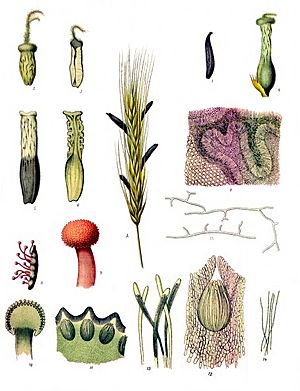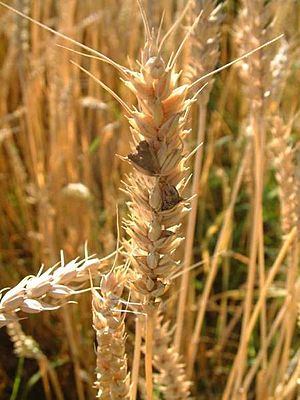Ergot facts for kids
Quick facts for kids Ergot |
|
|---|---|
 |
|
| Claviceps purpurea | |
| Scientific classification |
|
| Kingdom: | Fungi |
| Division: | Ascomycota |
| Class: | Sordariomycetes |
| Order: | Hypocreales |
| Family: | Clavicipitaceae |
| Genus: | Claviceps Tul., 1853 |
| Species | |
|
About 50, including: |
|
Ergot (pronounced UR-gət) is the name for a group of fungi from the genus Claviceps. These fungi grow on plants, especially grains like rye. When people or animals eat grains infected with ergot, it can make them very sick. This sickness is called ergotism.
The most well-known type of ergot fungus is Claviceps purpurea, also known as "rye ergot fungus." It produces natural chemicals called alkaloids. These chemicals are what cause the illness.
There are about 50 different kinds of Claviceps fungi. Most of them live in warm, tropical areas. Some important types include C. purpurea (which affects grasses and cereals), C. fusiformis (on pearl millet), and C. africana (on sorghum). C. purpurea often infects plants that have open flowers, like rye, triticale, wheat, and barley. It rarely affects oats.
C. purpurea has at least three different types, which prefer different host plants:
- G1 — Grows on grasses in open fields.
- G2 — Grows on grasses in wet, forest, and mountain areas.
- G3 (C. purpurea var. spartinae) — Grows on salt marsh grasses.
Contents
Life cycle of Ergot Fungi
An ergot kernel, which is a hard, dark mass, forms when a tiny spore from a Claviceps fungus infects a flower of a grass or cereal plant. The fungus gets into the flower in a way that is similar to how pollen fertilizes a plant. For the infection to happen, the fungal spore needs to reach the flower's stigma. This is why ergot mainly infects plants with open flowers that are pollinated by wind, such as rye and ryegrasses.
First, the fungus grows a soft, white tissue inside the flower. This tissue makes a sugary liquid called honeydew. This honeydew often drips from the infected flowers. It contains millions of asexual spores, which insects help spread to other flowers. Later, this soft tissue turns into a hard, dry kernel, or sclerotium, inside the plant's husk. This is when the harmful chemicals (alkaloids) build up in the kernel.
When a mature ergot kernel falls to the ground, the fungus stays inactive until conditions are right, like in spring or after rain. Then, it starts to grow, forming small, mushroom-like structures. These structures release sexual spores into the air. These spores are released when suitable grass plants are flowering, ready to start the infection cycle again. Ergot infection can reduce how much grain or hay a farmer gets. If farm animals eat infected grain or hay, they can get sick with ergotism.
Most people know C. purpurea by its black, sticking-out kernels. But many ergot fungi in tropical areas have brown or grayish kernels that look like the plant's own seeds. This makes the infection harder to spot. Insects like flies and moths can carry ergot spores, but we don't know if they help spread the fungus from sick plants to healthy ones.
How Ergot Affects People and Animals
Ergotism is a serious illness that affects humans and animals who eat plants or grains contaminated with ergot. It's sometimes called "St. Anthony's Fire" because of the severe burning feeling it causes in the limbs. This name also comes from the Hospital Brothers of St. Anthony, a group of monks who helped people suffering from ergotism.
There are two main types of ergotism:
- Convulsive Ergotism: This type causes muscle spasms, fever, and hallucinations. People might seem confused, unable to speak, or have tremors. They can also experience strange visions or distorted perceptions.
- Gangrenous Ergotism: This type causes intense burning pain, especially in the fingers and toes. It happens because the ergot chemicals make blood vessels tighten (called vasoconstriction), reducing blood flow. This can lead to gangrene, where body tissue dies, sometimes causing people to lose their fingers, toes, or even limbs.
Ergot in History
Ergot poisoning, or ergotism, is one of the earliest recorded cases of poisoning caused by toxic molds. Records of ergot poisoning go back as far as 600 BC. An ancient tablet from Assyria mentioned a "noxious pustule in the ear of grain." In 350 BC, the Parsees described "harmful grasses that cause severe illness." In ancient Syria, ergot was called "Daughter of Blood."
During the Middle Ages, it was common for people in Europe to get sick from eating rye bread made with ergot-infected grain. The first major outbreak of gangrenous ergotism in Europe was in Germany in 857. After this, France and Scandinavia also had outbreaks. England was not affected as much because their main food was wheat, which is more resistant to ergot fungi. In 944, a huge outbreak in France killed 40,000 people.
In 1596, Johannes Thallius was one of the first to connect ergotism to poisoned grain. In 1778, S. Tessier, after seeing a large outbreak in France where over 8,000 people died, suggested draining fields, cleaning grain, and using potatoes instead of affected grain.
Saint Anthony's Fire and the Antonites
In 1722, the Russian Tsar Peter the Great had to stop his army's campaign against the Ottoman Empire. His soldiers, traveling through the Terek steppe, became sick with ergotism and had to retreat to find safe food. A diary from that time describes how people became dizzy and had strong muscle contractions after eating the poisoned bread. Those who didn't die quickly found their hands and feet falling off, similar to frostbite.
This epidemic was known as Saint Anthony's Fire. Some historical events, like the Great Fear in France during the French Revolution, have been linked to ergot poisoning. Saint Anthony was a religious figure from the 3rd century. He was known for having difficult visions and temptations. Two noblemen credited him with helping them recover from the disease. Because of this, they started the Order of St. Anthony in his honor.
The Order of St. Anthony, also called Antonites, grew quickly. Their hospitals spread across France, Germany, and Scandinavia. They became wealthy as grateful people gave them money and gifts. By the end of the Middle Ages, they had many hospitals. People would visit these hospitals and even donate limbs they had lost to ergotism, which were displayed near shrines. These centers were some of the first specialized medical systems in Europe. The monks knew a lot about treating ergotism and its terrible effects.
Patients would receive ergot-free meals and special balms that helped with pain and blood flow. Their medical recipes are mostly lost now, but some treatments were recorded. After 1130 AD, the monks were not allowed to perform surgeries, so they hired barber surgeons to remove dead limbs and treat open wounds.
A key part of the Antonites' treatment was making sure patients did not eat rye bread or other foods containing ergot. This stopped the disease from getting worse. There was no known cure for ergotism itself, but they treated the symptoms like blood problems, nerve issues, and hallucinations. If a person survived the initial poisoning and stopped eating ergot, their health would often improve, even if they had lost limbs.
It is thought that poor people and children were most likely to get ergotism. This was because entire villages sometimes depended on tainted crops for food, especially during times of famine. Ergot fungus is not destroyed by heat or water, so it often ended up in bread made from rye flour. While other grasses can be infected, rye was the main grain eaten in Medieval Europe. The effects of ergot depended on how much was eaten, the mix of chemicals in the ergot, and the person's age and health.
The Antonites' influence began to decline after doctors discovered what caused ergotism. They then recommended ways to remove the ergot kernels from rye crops. In 1776, the Antonite monasteries were taken over by the Maltese Knights Hospitaller. Many of their medical records and recipes for treating ergotism were lost because they were no longer used or preserved.
See also
 In Spanish: Claviceps para niños
In Spanish: Claviceps para niños


